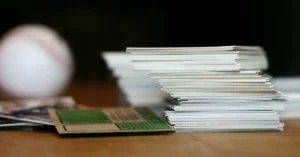Unravel the colorful history behind the iconic orange basketball with my expert insights. Discover the fascinating reasons about the question: Why is a basketball orange? And delve into the sport’s evolution and traditions.
Why is a Basketball Orange: Historical Development of Basketball Color
In the early days, you might have noticed that basketballs weren’t the vibrant orange you’re accustomed to today. Initially, they boasted a rather inconspicuous brown color, due mainly to the leather used in their construction. This was practical, but it wasn’t ideal when spotting the ball during play.
Tony Hinkle, a name you might be curious about, was central to this color revolution. As a coach deeply entrenched in the history and evolution of the game, Hinkle recognized the need for a ball that would stand out against both the court and the players. That’s when the orange-colored basketball was introduced.
| Era | Basketball Color |
|---|---|
| Pre-1950s | Brown |
| Post-1950s | Orange |
The transition to the orange hue served a dual purpose. For you, the player or spectator, it meant a significantly better visual experience. For the sport itself, it led to a dynamic change in how the game was played and followed. Besides being a functional upgrade, the orange basketball soon became an iconic sport symbol.
Over time, the standard brown shifted to the orange we recognize today. Even the womens’ leagues played with a ball with distinctive orange and oatmeal-colored panels for better identification. This quirky but effective advancement in basketball’s visual appeal has persisted, and now it’s nearly impossible to imagine the game without the instantly recognizable orange basketball.
Influence on Visibility and Gameplay

- Contrast on the Court: The vibrancy of orange provides a stark contrast against the wooden floor and the players’ jerseys, which helps to prevent the ball from blending into the environment. This choice in color makes it easy for you to track the ball’s movement, whether you’re playing or cheering from the stands.
- Spectator Experience: For the audience, both on-site and watching from home, the orange basketball enhances the viewing experience. It keeps you engaged, as the ball remains visible even at high speeds and from a distance.
- Gameplay Precision: From the players’ standpoint, quickly spotting the ball is crucial for making those split-second decisions that can turn the tide of a game. The clear visibility of the orange ball aids in accurate passing, shooting, and dribble moves.
Design and Structure

When you’re on the court, the basketball in your hands has a distinctive design and structure. The standard basketball is crafted with eight panels, key to its iconic shape and form. Historically, basketballs were a duller shade, but now they boast a striking orange hue for better visibility.
The panels, known as ribs, are separated by thin black lines, providing texture and grip. The design of these panels and ribs is crucial; it ensures that when you make that crucial shot, your grip and control are optimized. It’s not simply about the look – it’s about function too.
Here’s a fun fact: the switch to the vibrant orange occurred in the late 1950s. Initially, balls used to be brown, but they were not as easy to see as the current orange ones, designed to catch both the player’s and spectator’s eyes. This color change significantly improved the game’s visual experience.
Basketballs are made from various materials. Some are crafted from genuine leather, especially the ones used in professional games, such as Spalding and Bros. Leather provides a soft, premium feel, however, it is not well-suited for outdoor play. There are also basketballs made from a synthetic composite, which are more durable for all courts.
| Material | Benefits | Usage |
|---|---|---|
| Genuine Leather | Soft, premium feel | Indoor play |
| Synthetic | Durable, all-weather resistant | Outdoor play |
Basketballs in Professional Leagues

In professional basketball leagues, the color of the basketball has become a symbol of the sport itself. The ball zipping across the court is iconically orange when you watch an NBA game. This color choice is not just for aesthetics; it serves a practical purpose. The distinct orange hue ensures excellent visibility for both players and spectators.
The National Basketball Association adopted the orange basketball in the late 1950s, and it has been a staple ever since. NBA basketballs are made with a standard color and design to provide uniformity in gameplay across all teams and venues.
In contrast, the Women’s National Basketball Association (WNBA) added a bit more flair to the traditional look. WNBA balls have a mix of orange and oatmeal-colored panels, providing a unique appearance while still maintaining that essential visibility. This design isn’t just about looks; it’s about creating a distinct identity for the women’s league.
- NBA: Traditional Orange
- WNBA: Orange and Oatmeal Panels
Other professional basketball leagues around the world sometimes put their own twist on basketball colors. However, for the most pivotal games you watch, from NCAA championships to the NBA finals, the basketball you’re encouraging your favorite team to slam through the hoop will gleam with that familiar and reassuring orange.
Consumer Perception and Market Trends

When you pick up a basketball, the vibrant orange color may not seem like a big deal, but it’s a key factor in consumer perception. The color scheme of a basketball is not just for show; it plays a critical role in the ball’s visibility during play, which is crucial for you as a player and fans spectating the game. Over the years, manufacturers have realized that an orange basketball stands out better against most backdrops, such as wooden courts or outdoor environments.
Regarding market trends, basketballs with an orange hue often catch your eye in stores, influencing purchasing decisions, especially among youth and newbie players attracted to its energetic appearance. Additionally, the bold color can have a promotional advantage, making the ball visually appealing in advertisements and social media campaigns.
Here’s a brief breakdown of how the orange basketball aligns with market trends:
- Visibility: Ensures the ball stands out for players and spectators.
- Aesthetics: The color is appealing and can increase the ball’s attractiveness to consumers.
- Branding: The iconic orange basketball has become synonymous with the sport itself.
The author of an article about basketballs might emphasize that the choice of orange was intentional, aiding in the product’s marketability and overall appeal. More than just a color, the orange hue of a basketball has a psychological effect, amplifying excitement and enhancing the game experience.
Regulations and Standards

When you play basketball, be it casually or in a formal setting like the NCAA Championship, some specific regulations and standards ensure consistency and fairness of the game. These are essential for everyone involved, especially referees, who enforce these rules.
Basketball Size: For men’s games, the standard basketball size is 7, corresponding to a circumference of about 29.5 inches. Women’s games use a slightly smaller size 6, with a circumference of approximately 28.5 inches.
Regulation Colors: While the iconic orange hue is the norm for basketballs, the regulations are more concerned with visibility. The orange color aids in ensuring that the ball is easily spotted by players and spectators alike.
Consistency Across Games: Maintaining consistent ball standards is crucial across various levels of play, from high school to professional leagues. This includes not just size and color, but also texture and material, which affect players’ grip and the overall gameplay.
Rules You Need to Know:
- The ball must be spherical.
- It must be made of a leather or synthetic leather material.
- The ball should have a deeply-pebbled surface and horizontally shaped panels.
Here’s a quick reference you might find helpful:
| Feature | Men’s Standard | Women’s Standard |
|---|---|---|
| Size | 7 | 6 |
| Circumference | ~29.5 inches | ~28.5 inches |
| Color | Orange (for visibility) | Orange |
| Material | Leather/Synthetic | Leather/Synthetic |
Technological Advances and Materials

When you play basketball, you’re not just tossing any round object through a hoop; you’re experiencing years of material innovation at your fingertips. Basketball construction has evolved to give you the best performance on the court. At the core of the basketball is the rubber bladder, which holds air and creates the structure you need to dribble and shoot smoothly.
Spalding, the iconic sporting goods company, has crafted balls for the NBA with intricate fiber levels for optimal grip and durability. The outer cover has advanced too, with materials like high-quality composite leather that withstands intense play and moisture without losing its tactile feel.
Here’s a brief snapshot of the basketball’s make-up:
- Outer Material: Composite/Full-grain leather
- Core: Inflatable rubber tube
- Layers: Multiple fiber levels
Not only has the material composition advanced, but the color of the ball has undergone changes for practical reasons. The traditional brown was difficult to see, so a distinct orange pigment was introduced to improve visibility. This color-change ensures that you, the referees, and fans can keep their eyes on the ball, tracking its every movement across the varnished parquet.
Additionally, today’s basketballs might include a variety of other materials, imparting characteristics like softness for a gentle touch or sturdiness for outdoor use. Down to the microscopic, each detail is curated to enhance your play.
FAQ
Why is basketball so orange?
Basketball is typically orange because it offers high visibility against various court backgrounds. The bright color makes it easier for players to see the ball during gameplay, enhancing their ability to track its movement and make precise passes and shots.
What is the exact color of a basketball?
The exact color of a basketball can vary slightly depending on the brand and specific manufacturing process. However, most basketballs are a vibrant shade of orange, with some variations in hue and tone.
What is the history of the orange basketball?
The adoption of the orange basketball dates back to the late 1950s when the Basketball Association of America (BAA), which later merged with the National Basketball League (NBL) to form the NBA, introduced it as the standard basketball color. The decision was made to improve visibility and enhance the viewing experience for players and fans.
Are NBA basketballs brown or orange?
NBA basketballs are primarily orange, though they may appear slightly brownish due to the leather material used in their construction. The distinctive orange color ensures high visibility and consistent performance on the court.
If you enjoyed reading about the topic: Why is a Basketball Orange, leave a comment and stay updated on Pinterest for more exciting basketball news.
Leave me a comment and make sure to also check out The 4 Tallest NBA Players in History.






